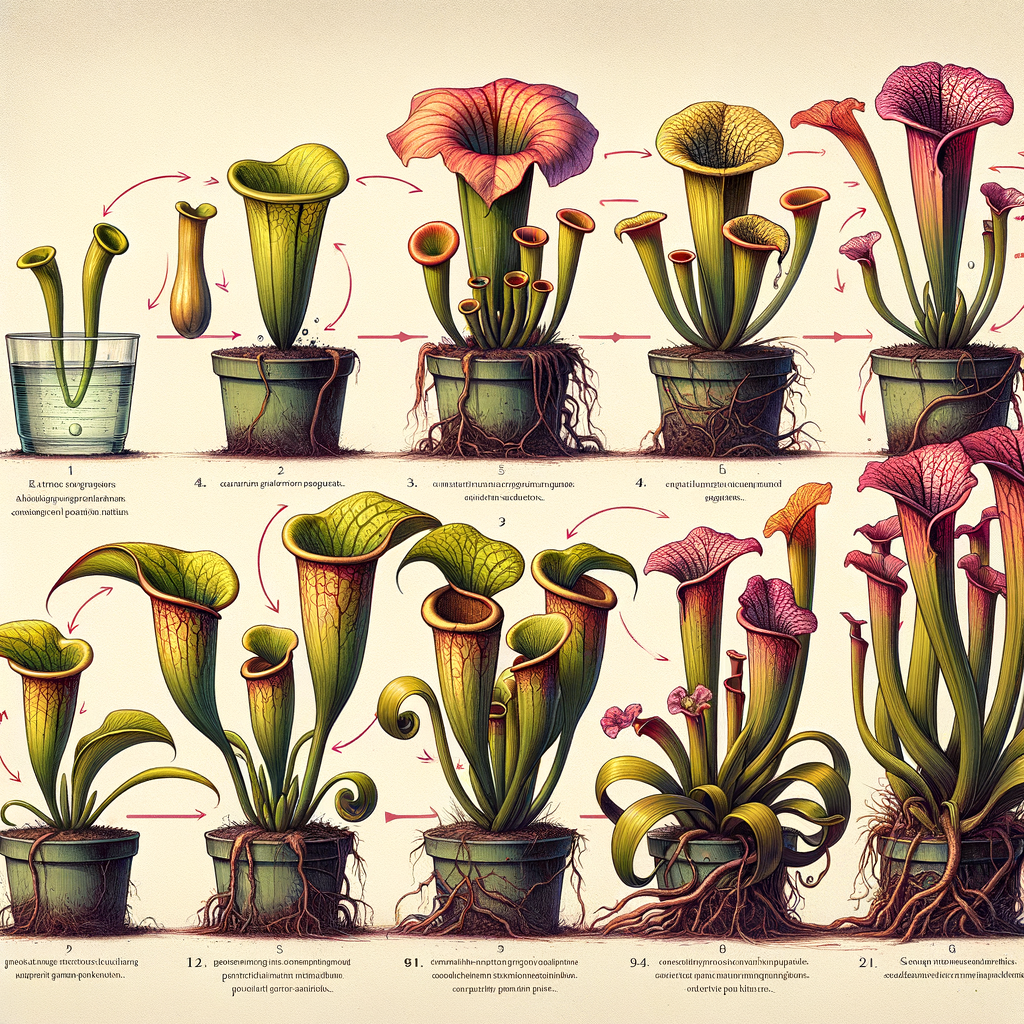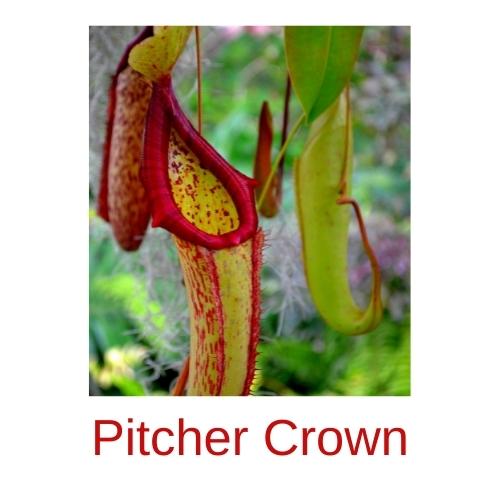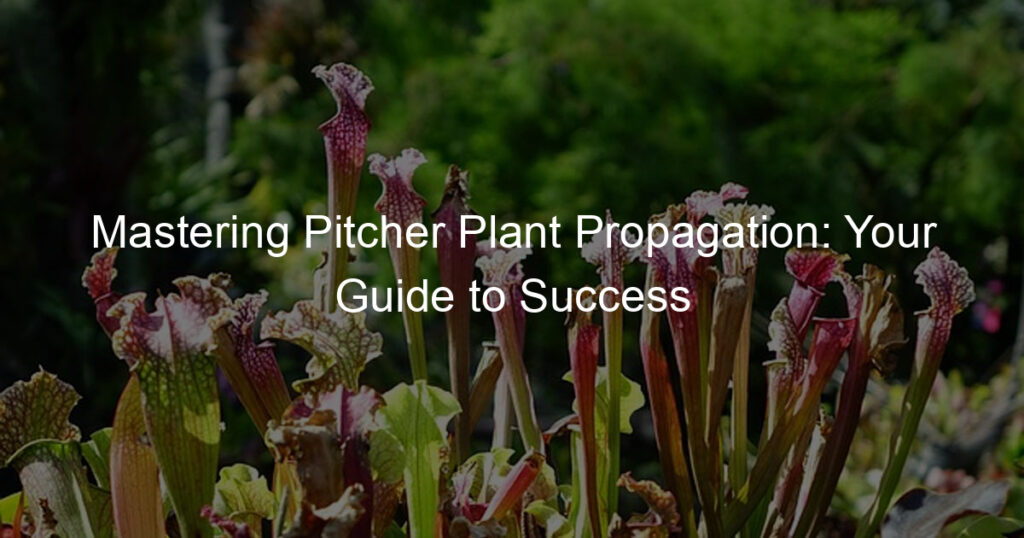
Introduction to Pitcher Plant Propagation
Welcome to our comprehensive guide on Pitcher Plant Propagation. In this section, we will introduce you to the basics of propagating these fascinating carnivorous plants and explain why this process is beneficial.
- Understanding the basics of Pitcher Plant Propagation
- Why Propagating Pitcher Plants is beneficial
Pitcher plants are unique in their feeding habits, relying on insects rather than soil nutrients for sustenance. This makes their propagation – or the process of growing new plants from a variety of sources such as seeds, cuttings, or other plant parts – a bit different from other plants. The key to successful propagation is understanding the plant’s natural environment and replicating those conditions as closely as possible.
Propagating pitcher plants can be a rewarding experience for several reasons. Firstly, it allows you to grow more plants without the need to purchase them. Secondly, it helps conserve these unique species, many of which are endangered due to habitat loss. Lastly, pitcher plants are excellent for controlling pests in your garden as they naturally attract and consume insects.
Stay tuned as we delve deeper into the methods for propagating pitcher plants, how to ensure successful propagation, and how to care for your pitcher plants to ensure healthy growth. We will also provide you with some handy tips and techniques for cultivating pitcher plants. Let’s embark on this exciting journey of pitcher plant propagation together!
Methods for Propagating Pitcher Plants
There are several methods to propagate pitcher plants, but one of the most common and effective methods is through seed propagation. This method involves collecting and preparing seeds from mature plants and then planting them in suitable conditions to germinate and grow into new plants.
Seed Propagation
Seed propagation is a natural way to grow pitcher plants. It involves two main steps: collecting and preparing the seeds, and the planting and germination process.
- How to Collect and Prepare Seeds
- Planting and Germination Process
Collecting seeds from pitcher plants is a delicate process. The seeds are typically found inside the flowers of mature plants. Once the flowers have dried out, you can gently shake them to release the seeds. After collecting the seeds, it’s important to prepare them for planting. This involves cleaning the seeds and then soaking them in water for about 24 hours. This helps to soften the seed coat and promote germination.
After the seeds have been prepared, they are ready to be planted. Plant the seeds in a pot filled with a suitable growing medium, such as peat moss or perlite. The seeds should be lightly covered with the growing medium and then watered thoroughly. The pot should be placed in a warm, bright location, but out of direct sunlight. Germination can take several weeks, so patience is key. Once the seedlings have developed their first set of true leaves, they can be transplanted to their permanent location.
Seed propagation is a rewarding method of growing pitcher plants, but it does require patience and care. The process can be a bit slow, but the result is a new generation of beautiful and unique pitcher plants.
Cuttings Propagation
Propagation by cuttings is a popular method for growing pitcher plants. It involves taking a piece of the plant and encouraging it to grow into a new plant. Let’s dive into this process.
- Choosing the Right Cutting
- Steps to Successful Propagation from Cuttings
- Prepare the Cutting: Remove any flowers or fruit from the cutting. Also, remove the lower leaves, leaving only 2-3 leaves at the top.
- Dip in Rooting Hormone: Dip the cut end of the stem in a rooting hormone. This promotes root growth and helps the cutting establish itself more quickly.
- Plant the Cutting: Plant the cutting in a pot filled with a well-draining soil mix. The cut end should be buried about 1-2 inches deep.
- Care for the Cutting: Place the pot in a location with bright, indirect light. Keep the soil moist but not waterlogged. In a few weeks, the cutting should start to develop roots and new growth.
Choosing the right cutting is the first step in successful propagation. A healthy, mature pitcher plant is the best source for cuttings. Look for a stem that is robust and has several leaves. The cutting should be about 4-6 inches long. It’s best to take cuttings in the spring or early summer when the plant is actively growing.
Once you have your cutting, follow these steps:
| Step | Description |
|---|---|
| Choose a Cutting | Select a healthy, mature stem about 4-6 inches long |
| Prepare the Cutting | Remove flowers, fruit, and lower leaves |
| Dip in Rooting Hormone | Dip the cut end in a rooting hormone to promote root growth |
| Plant the Cutting | Plant the cutting 1-2 inches deep in a pot with well-draining soil |
| Care for the Cutting | Place in bright, indirect light and keep soil moist |
With patience and care, your pitcher plant cuttings will grow into healthy, thriving plants. Happy planting!
Successful Pitcher Plant Propagation
Propagating pitcher plants successfully requires a keen understanding of several key factors. These factors, when given due attention, can significantly increase your chances of success. Let’s delve into these key factors.
Key Factors for Success
Two of the most crucial factors for successful pitcher plant propagation are understanding the importance of humidity and temperature, and choosing the right soil and pot. Let’s explore these factors in more detail.
- Understanding the Importance of Humidity and Temperature
- Choosing the Right Soil and Pot
Pitcher plants thrive in environments with high humidity and specific temperature ranges. They prefer a humidity level of around 50-70%. As for temperature, most pitcher plants do well in temperatures between 70-95 degrees Fahrenheit during the day, and 60-70 degrees at night. Understanding these requirements and providing the right conditions can greatly enhance the growth and development of your pitcher plants.
The choice of soil and pot can also significantly influence the success of your pitcher plant propagation. Pitcher plants prefer a soil mix that is low in nutrients, such as a mix of sphagnum moss and perlite. As for the pot, it should have good drainage to prevent waterlogging, and be large enough to accommodate the plant’s growth. Remember, a happy pitcher plant is one that is in the right soil and pot!
By paying attention to these key factors, you can significantly increase your chances of successfully propagating pitcher plants. Remember, every plant is unique, and what works for one may not work for another. So, keep experimenting until you find what works best for your pitcher plants.
Common Mistakes and How to Avoid Them
When it comes to propagating pitcher plants, there are a couple of common mistakes that people often make. These mistakes can hinder the growth and health of your plants. But don’t worry, we’re here to help you avoid these pitfalls and ensure your pitcher plants thrive.
- Overwatering and Underwatering
- Incorrect Light Conditions
One of the most common mistakes is either giving your pitcher plants too much water or not enough. Both can be harmful. Overwatering can lead to root rot, while underwatering can cause the plant to dry out and die.
So, how much water should you give your pitcher plants? A good rule of thumb is to keep the soil moist but not waterlogged. If the top inch of soil is dry, it’s time to water your plant. But remember, it’s better to underwater than overwater. If you’re unsure, it’s best to err on the side of caution and give less water.
Another common mistake is not providing the right light conditions. Pitcher plants need plenty of indirect sunlight to grow. However, too much direct sunlight can scorch the leaves and cause the plant to wither.
To avoid this, place your pitcher plants in a location where they can get plenty of bright, indirect light. If you’re growing your plants indoors, consider using a grow light to supplement natural light. But remember, moderation is key. Too much light can be just as harmful as too little.
By avoiding these common mistakes, you can ensure your pitcher plants grow healthy and strong. Remember, the key to successful plant propagation is understanding the needs of your plants and providing the right conditions for them to thrive.
How to Grow Pitcher Plants
One of the most fascinating aspects of nature is the diversity of plant life. Among them, pitcher plants are a unique group that has captured the interest of many plant enthusiasts. These carnivorous plants, known for their unique shape and hunting strategy, can be a great addition to your indoor garden. Let’s explore how to grow pitcher plants indoors.
Indoor Pitcher Plant Propagation
Propagating pitcher plants indoors requires a bit of knowledge and care. The process involves two main steps: creating the right indoor environment and providing the appropriate care. Let’s dive into these steps in more detail.
- Creating the Right Indoor Environment
- Indoor Care Tips
Pitcher plants thrive in a humid environment, similar to their natural habitat in the tropical rainforests. To create this environment indoors, you can use a terrarium or a humidifier. The ideal temperature for these plants is between 70-80 degrees Fahrenheit during the day and 60-70 degrees at night. They also need plenty of light, so place them near a window or use artificial lights.
Once the right environment is set, the next step is to provide the right care. Water your pitcher plants with rainwater, distilled water, or reverse osmosis water as tap water can be harmful to them. They don’t require fertilizers as they get their nutrients from the insects they trap. Also, remember to trim off any dead or yellow leaves to promote new growth.
In conclusion, growing pitcher plants indoors can be a rewarding experience if you create the right environment and provide the right care. With a little patience and effort, you can enjoy the unique beauty of these carnivorous plants in your own home.
Outdoor Pitcher Plant Propagation
Propagating pitcher plants outdoors can be a rewarding experience. However, it requires a clear understanding of the plant’s outdoor requirements and proper care techniques. Let’s explore these aspects in detail.
- Understanding Outdoor Requirements
Pitcher plants are unique, and they thrive best in a specific outdoor environment. They prefer a humid environment with plenty of sunlight. The soil should be well-drained but consistently moist. A mixture of peat moss and sand or perlite is often ideal.
It’s also important to note that pitcher plants require a dormant period during winter. This means they can withstand colder temperatures, but it’s best to protect them from extreme cold.
- Outdoor Care Tips
Once you understand the outdoor requirements, the next step is to ensure proper care for your pitcher plants. Here are some tips:
- Watering: Keep the soil consistently moist but avoid waterlogging. Use rainwater or distilled water as tap water may contain minerals that are harmful to the plant.
- Light: Ensure the plant gets plenty of sunlight. However, protect it from the scorching midday sun.
- Feeding: Pitcher plants are carnivorous and don’t require traditional plant food. They catch insects in their pitchers for nutrition. However, if insects are scarce, you can supplement with a small amount of appropriate food.
- Winter Care: During the dormant period, reduce watering and protect the plant from extreme cold.
Remember, patience is key when propagating pitcher plants outdoors. With the right conditions and care, your plant will thrive and reward you with its unique beauty.
Pitcher Plant Care
Proper care of your Pitcher Plant is essential for its healthy growth and longevity. This section will focus on two key aspects of Pitcher Plant care: feeding and watering.
Feeding and Watering
Just like any other living organism, Pitcher Plants need proper nourishment and hydration to thrive. Let’s delve into what to feed your Pitcher Plant and the best watering techniques for its healthy growth.
- What to feed your Pitcher Plant
- Watering techniques for healthy growth
Pitcher Plants are carnivorous, meaning they derive their nutrients from insects. They attract, trap, and digest insects using their pitcher-shaped leaves filled with digestive enzymes. However, if your plant is indoors or in an area with fewer insects, you can supplement its diet with freeze-dried insects or insect pellets available at garden centers. Remember, overfeeding can harm your plant. A small insect or a pinch of insect food every two weeks is sufficient.
Watering your Pitcher Plant correctly is crucial for its survival. These plants prefer a humid environment and moist soil, but they don’t like waterlogged roots. Therefore, it’s best to water them from the bottom. Fill the saucer under your plant pot with distilled water or rainwater, as tap water often contains minerals that can harm your plant. The soil will absorb the water it needs, and you can empty the excess water after an hour. During hot and dry periods, you may need to water your plant more frequently.
By following these feeding and watering guidelines, you can ensure your Pitcher Plant thrives and continues to be a fascinating addition to your home or garden.
Pruning and Repotting
One of the most important aspects of Pitcher Plant care is proper pruning and repotting. This process not only helps to maintain the plant’s health but also encourages new growth. Let’s explore these two crucial steps in detail.
- When and how to prune your Pitcher Plant
- Steps to successful repotting
- First, gently remove the plant from its current pot. Be careful not to damage the roots.
- Next, prepare a new pot that is slightly larger than the current one. Fill it with a suitable potting mix for carnivorous plants.
- Place the plant in the new pot and gently fill in around the roots with more potting mix.
- Finally, water the plant thoroughly and place it in a location with suitable light and temperature conditions.
Pruning is a vital part of Pitcher Plant care. It is best to prune your plant during the late winter or early spring, as this is when the plant is in its dormant stage. This timing allows the plant to recover quickly and start new growth in the upcoming growing season.
To prune your Pitcher Plant, you will need a pair of sharp, clean pruning shears. Begin by removing any dead or dying leaves from the plant. These are typically brown or yellow in color. Next, cut back any overgrown vines to maintain the plant’s shape and size. Be careful not to cut into the main stem of the plant, as this can cause damage.
Repotting your Pitcher Plant is another essential step in maintaining its health and growth. It is generally recommended to repot your plant every 2-3 years. Here are the steps to successfully repot your Pitcher Plant:
By following these steps for pruning and repotting, you can ensure that your Pitcher Plant remains healthy and vibrant for many years to come.
Propagation Techniques for Pitcher Plants
Propagation is a process that allows us to create new plants from the existing ones. This process is especially useful when it comes to pitcher plants, as it allows us to grow more of these fascinating carnivorous species. Let’s delve into some advanced techniques for propagating pitcher plants.
Advanced Techniques
While there are several methods to propagate pitcher plants, two techniques stand out for their effectiveness and efficiency. These are tissue culture propagation and layering propagation. Let’s explore each one in detail.
- Tissue Culture Propagation
- Layering Propagation
Tissue culture propagation, also known as micropropagation, involves growing new plants from small pieces of the parent plant in a sterile environment. This method is highly effective, as it can produce a large number of plants in a short time. However, it requires specialized equipment and knowledge, making it more suitable for professional growers or serious hobbyists.
Layering propagation is a more traditional method that involves bending a stem of the parent plant to the ground and covering a part of it with soil. Over time, this stem section will develop roots and can be separated to form a new plant. This method is simpler than tissue culture propagation, but it takes longer and produces fewer plants.
Both these methods have their own advantages and can be chosen based on your resources and patience. Remember, propagation is not just about creating new plants, but also about learning and enjoying the process. So, choose the method that you find most enjoyable and rewarding.
| Propagation Method | Advantages | Disadvantages |
|---|---|---|
| Tissue Culture Propagation | Produces a large number of plants quickly | Requires specialized equipment and knowledge |
| Layering Propagation | Simpler and requires less equipment | Takes longer and produces fewer plants |
In conclusion, propagation is an exciting and rewarding part of growing pitcher plants. Whether you choose tissue culture propagation or layering propagation, the joy of seeing a new plant grow from a piece of the parent plant is truly unmatched.
Cultivating Pitcher Plants
When it comes to cultivating pitcher plants, creating the perfect environment is crucial. This involves understanding the plant’s light requirements and choosing the right soil mix. Let’s delve into these aspects to ensure your pitcher plants thrive.
Creating the Perfect Environment
Just like humans, plants also need a comfortable environment to grow and flourish. For pitcher plants, this means the right amount of light and the right type of soil. Let’s explore these two key factors.
- Understanding light requirements
- Choosing the right soil mix
Pitcher plants love light. They need a good amount of sunlight to grow well. Ideally, they should receive about 12 hours of light each day. However, they can also tolerate lower light levels. But remember, too little light can make them weak and pale. So, make sure your pitcher plants are getting enough light, but not too much to avoid scorching them.
The soil is the home for your pitcher plants. It’s where they get their nutrients from. Pitcher plants prefer a well-draining, acidic soil mix. You can create this by mixing equal parts of peat moss and perlite. This type of soil mix ensures that the roots of your pitcher plants get enough air and water. Remember, too much water can cause root rot, and too little can make them dry out. So, keep the soil moist but not waterlogged.
By understanding the light requirements and choosing the right soil mix, you can create the perfect environment for your pitcher plants. This will help them grow strong and healthy, and you’ll be able to enjoy their unique beauty for a long time.
Pitcher Plant Growth Tips
When it comes to growing pitcher plants, understanding their growth cycles and knowing how to encourage healthy growth are key. Let’s delve into these topics to help you become a successful pitcher plant gardener.
- Understanding growth cycles
Pitcher plants, like all living organisms, go through different stages of growth. These stages are often referred to as growth cycles. Understanding these cycles can help you provide the right care at the right time.
The growth cycle of a pitcher plant typically includes a period of active growth, followed by a period of dormancy. During the active growth period, the plant produces new leaves and pitchers. This period usually occurs during the warmer months of the year.
When the weather starts to cool, the plant enters a period of dormancy. During this time, the plant stops producing new leaves and pitchers and focuses its energy on surviving the colder months. Understanding these cycles can help you adjust your care routine accordingly.
- How to encourage healthy growth
Encouraging healthy growth in pitcher plants involves providing the right conditions and care. Here are some tips to help your pitcher plants thrive:
- Light: Pitcher plants need plenty of light to grow well. Make sure your plants get at least six hours of direct sunlight each day.
- Water: These plants prefer wet conditions. Keep the soil consistently moist, but not waterlogged.
- Soil: Pitcher plants require nutrient-poor, acidic soil. A mix of sphagnum moss and sand can work well.
- Temperature: Try to mimic the plant’s natural habitat. During the active growth period, keep the temperature between 70-95°F. During dormancy, a cooler temperature of 50-70°F is ideal.
- Feeding: Pitcher plants are carnivorous and get most of their nutrients from insects. If your plant is indoors or doesn’t catch many insects, you may need to feed it yourself. Small insects or a special carnivorous plant fertilizer can be used.
By understanding the growth cycles of pitcher plants and providing the right conditions, you can encourage healthy growth and enjoy the unique beauty of these fascinating plants.
Conclusion
In this informative journey, we have explored the fascinating world of pitcher plant propagation. Let’s take a moment to recap the key points we’ve learned.
- Recap of Key Points:
- Final Thoughts on Pitcher Plant Propagation:
Propagating pitcher plants is a rewarding process that requires patience and the right techniques. We’ve learned about various methods of propagation, including seed sowing, stem cuttings, and division. Each method has its own advantages and challenges, but all can lead to successful growth with proper care.
Proper care for pitcher plants involves maintaining the right environment, including light, temperature, and humidity conditions. We’ve also discussed the importance of using the right soil and water to ensure healthy growth.
Moreover, we’ve highlighted some growth tips, such as the importance of regular feeding and the need to avoid overwatering. These tips can help ensure your pitcher plants thrive.
Propagating pitcher plants can be a fun and rewarding hobby. These unique plants offer a fascinating glimpse into the world of carnivorous plants and can make a great addition to any home or garden.
With the right knowledge and care, you can successfully propagate and grow your own pitcher plants. Remember, patience is key in this process, and the reward is well worth the effort. Happy planting!








